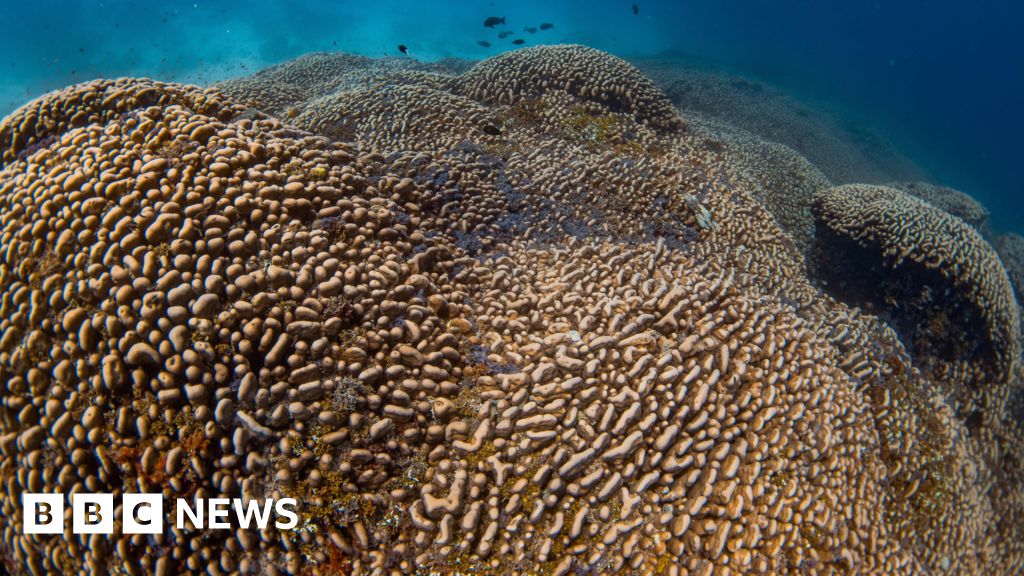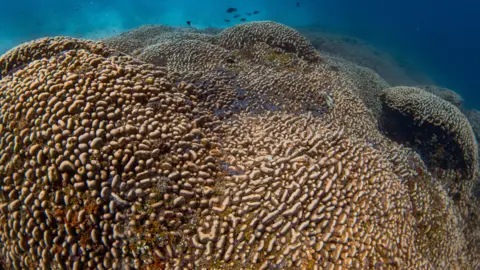 Photo by Manu San Félix, National Geographic Pristine Sea
Photo by Manu San Félix, National Geographic Pristine SeaThe largest coral ever recorded has been discovered by scientists in the southwest Pacific Ocean.
Giant corals are made up of many small creatures linked together to form a single organism rather than a reef, and can be more than 300 years old.
According to the research team, it is larger than a blue whale.
The photo was discovered by a videographer working on a National Geographic ship visiting remote parts of the Pacific Ocean to see the effects of climate change.
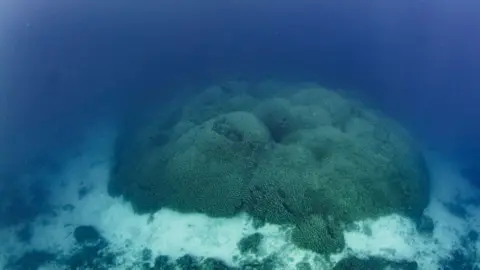 Manu Saint Felix, National Geographic’s Pristine Sea
Manu Saint Felix, National Geographic’s Pristine Sea“When I went to dive where the map said there was a shipwreck, I saw something,” said Manu Saint-Félix.
He called his diving buddy, his son Inigo, to dive deeper and investigate.
Seeing the coral in the Solomon Islands was like seeing an “underwater cathedral,” he said.
“It was very emotional. I felt a lot of respect for something that stayed in the same place for hundreds of years and survived,” he said.
“I thought, ‘Wow, this was here when Napoleon was alive,'” he added.
The expedition’s scientists measured the corals underwater using a type of tape measure. It is 34 meters wide, 32 meters long and 5.5 meters high.
Corals worldwide are facing severe pressure as oceans warm due to climate change.
Corals are made up of hundreds of thousands of organisms called polyps, each with its own body and mouth, that grow together as colonies. Some corals grow hard outer skeletons, and many of these fuse together to form coral reefs.
Some of these reefs can extend for very long distances, forming huge structures that are home to fish and other species.
According to the World Economic Forum, coral reefs support the livelihoods of one billion people through tourism and fisheries.
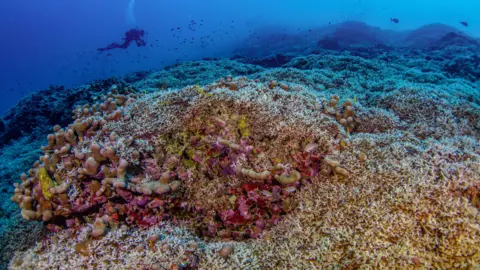 Manu Saint Felix, National Geographic’s Pristine Sea
Manu Saint Felix, National Geographic’s Pristine SeaThis specimen was found in deeper water than some coral reefs, which may have protected it from the high temperatures at the ocean surface.
The findings were announced at the same time as the United Nations climate change conference, COP29, in Baku, Azerbaijan, which seeks to advance efforts to tackle climate change.
Solomon Islands Climate Minister Trevor Manemahaga, who attended the summit, told BBC News that Solomon Islands would be proud of the newly discovered coral.
“We want the world to know that this is a special place and it needs to be protected,” he said.
“Corals are very, very important because we rely primarily on marine resources to survive economically (…) and ensuring that corals are not exploited is essential to our economic It’s very important and important for,” he said.
Small island nations like the Solomon Islands are highly vulnerable to climate change.
Manemahaga said he has seen first-hand the effects of global warming on the country, with it causing more powerful cyclones that erode coastlines and sink homes into the sea.
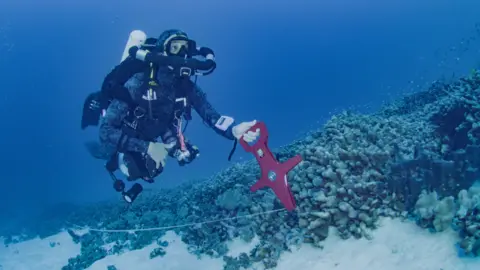 Photo credit: Manu San Félix, National Geographic Pristine Sea
Photo credit: Manu San Félix, National Geographic Pristine SeaMany developing countries participating in the talks are seeking more cash from rich countries to pay for strategies to tackle climate change.
Manemahaga said more funding for the Solomon Islands would help the island create more diverse jobs and mean fewer people working in industries that damage coral reefs.
Logging currently accounts for 50-70% of the country’s annual export revenue and is a major part of the country’s economy, but it also causes high levels of water pollution and damages corals in the region.
Eric Brown, a coral scientist on the National Geographic expedition, said the health of the corals “looked pretty good.”
“Shallow reefs nearby have degraded due to rising ocean temperatures, but witnessing this large, healthy coral oasis in slightly deeper waters is a ray of hope,” he said.
The coral is a species called Pavona clavus and is home to shrimp, crabs, fish, and other marine life.
The age of this specimen also means that it serves as a window into the history of past ocean conditions. Scientists want to study it to learn more about how it grew.
A report this week found that 44% of warm ocean corals are at risk of extinction, according to the International Union for Conservation of Nature. This is an increase of one-third since the species was last assessed in 2008.



